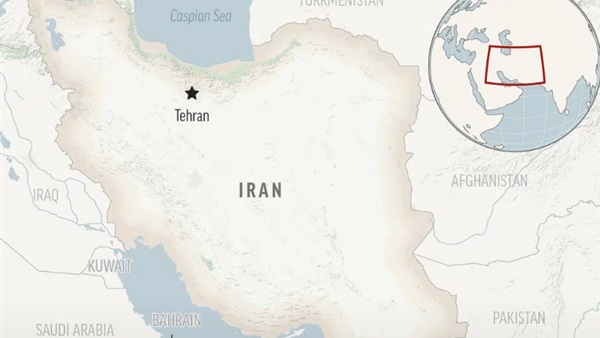Iran says drone attack targets defense facility in Isfahan

Bomb-carrying drones targeted an Iranian defense factory in
the central city of Isfahan overnight, authorities said early Sunday, causing
some damage at the plant amid heightened regional and international tensions
engulfing the Islamic Republic.
The Iranian Defense Ministry offered no information on who
it suspected carried out the attack, which came as a refinery fire separately
broke out in the country’s northwest and a 5.9 magnitude earthquake struck
nearby, killing three people.
However, Tehran has been targeted in suspected Israeli drone
strikes amid a shadow war with its Mideast rival as its nuclear deal with world
powers collapsed. Meanwhile, tensions also remain high with neighboring
Azerbaijan after a gunman attacked that country’s embassy in Tehran, killing
its security chief and wounding two others.
Details on the Isfahan attack, which happened around 11:30
p.m. Saturday, remained scarce. A Defense Ministry statement described three
drones being launched at the facility, with two of them successfully shot down.
A third apparently made it through to strike the building, causing “minor
damage” to its roof and wounding no one, the ministry said.
Iranian state television’s English-language arm, Press TV,
aired mobile phone video apparently showing the moment that drone struck along
the busy Imam Khomeini Expressway that heads northwest out of Isfahan, one of
several ways for drivers to go to the holy city of Qom and Tehran, Iran’s
capital. A small crowd stood gathered, drawn by anti-aircraft fire, watching as
an explosion and sparks struck a dark building.
“Oh my God! That was a drone, wasn’t it?” the man filming
shouts. “Yeah, it was a drone.”
Those there fled after the strike.
That footage of the strike, as well as footage of the
aftermath analyzed by The Associated Press, corresponded to a site on Minoo
Street in northwestern Isfahan that’s near a shopping center that includes a
carpet and an electronics store.
Iranian defense and nuclear sites increasingly find
themselves surrounded by commercial properties and residential neighborhoods as
the country’s cities sprawl ever outward. Some locations as well remain
incredibly opaque about what they produce, with only a sign bearing a Defense
Ministry or paramilitary Revolutionary Guard logo.
The Defense Ministry only called the site a “workshop,”
without elaborating on what it made. Isfahan, some 350 kilometers (215 miles)
south of Tehran, is home to both a large air base built for its fleet of
American-made F-14 fighter jets and its Nuclear Fuel Research and Production
Center.
The attack comes after Iran’s Intelligence Ministry in July
claimed to have broken up a plot to target sensitive sites around Isfahan. A
segment aired on Iranian state TV in October included purported confessions by
alleged members of Komala, a Kurdish opposition party that is exiled from Iran
and now lives in Iraq, that they planned to target a military aerospace
facility in Isfahan after being trained by Israel’s Mossad intelligence
service.
Activists say Iranian state TV has aired hundreds of coerced
confessions over the last decade. Israeli officials declined to comment on the
attack.
Separately, Iran’s state TV said a fire broke out at an oil
refinery in an industrial zone near the northwestern city of Tabriz. It said
the cause was not yet known, as it showed footage of firefighters trying to
extinguish the blaze. Tabriz is some 520 kilometers (325 miles) northwest of
Tehran.
State TV also said the magnitude 5.9 earthquake killed three
people and injured 816 others in rural areas in West Azerbaijan province,
damaging buildings in many villages.
Iran’s theocratic government faces challenges both at home
and abroad as its nuclear program rapidly enriches uranium closer than ever to
weapons-grade levels since the collapse of its atomic accord with world powers.
Nationwide protests have shaken the country since the
September death of Mahsa Amini, a Kurdish-Iranian woman detained by the
country’s morality police. Its rial currency has plummeted to new lows against
the U.S. dollar. Meanwhile, Iran continues to arm Russia with the bomb-carrying
drone that Moscow uses in attacks in Ukraine on power plants and civilian
targets.
Israel is suspected of launching a series of attacks on
Iran, including an April 2021 assault on its underground Natanz nuclear
facility that damaged its centrifuges. In 2020, Iran blamed Israel for a
sophisticated attack that killed its top military nuclear scientist.
Israeli officials rarely acknowledge operations carried out
by the country’s secret military units or its Mossad intelligence agency.
However, Israeli Prime Minister Benjamin Netanyahu, who recently re-entered the
premiership, long has considered Iran to be the biggest threat his nation
faces. The U.S. and Israel also just held their largest-ever military exercise
amid the tensions with Iran.
Meanwhile, tensions remain high between Azerbaijan and Iran
as Azerbaijan and Armenia have fought over the Nagorno-Karabakh region. Iran
also wants to maintain its 44-kilometer (27-mile) border with landlocked
Armenia — something that could be threatened if Azerbaijan seizes new territory
through warfare.
Iran in October launched a military exercise near the
Azerbaijan border. Azerbaijan also maintains close ties to Israel, which has
infuriated Iranian hard-liners, and has purchased Israeli-made drones for its
military.
Anwar Gargash, a senior Emirati diplomat, warned online that
the Isfahan attack represented one more event in the “dangerous escalation the
region is witnessing.” The United Arab Emirates was targeted in missile and
drone attacks last year claimed by Yemen’s Iran-backed Houthi rebels.
It “is not in the interest of the region and its future,”
Gargash wrote on Twitter. “Although the problems of the region are complex,
there is no alternative to dialogue.”





